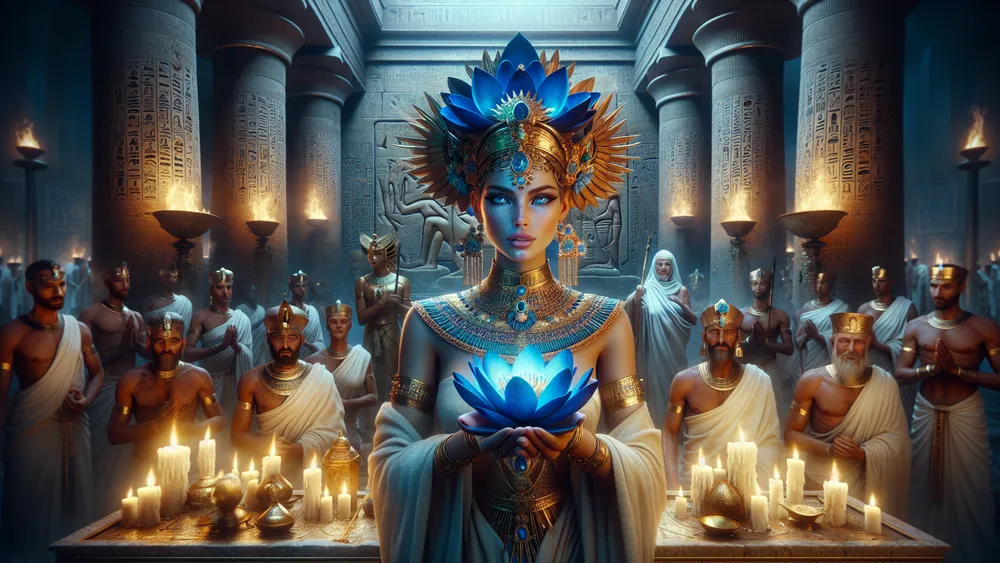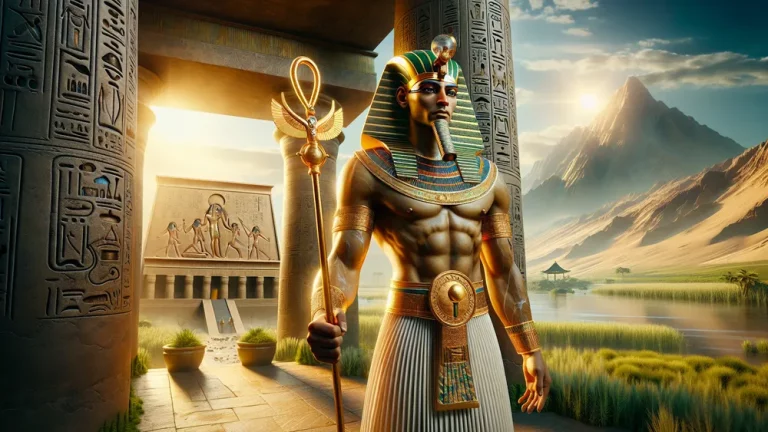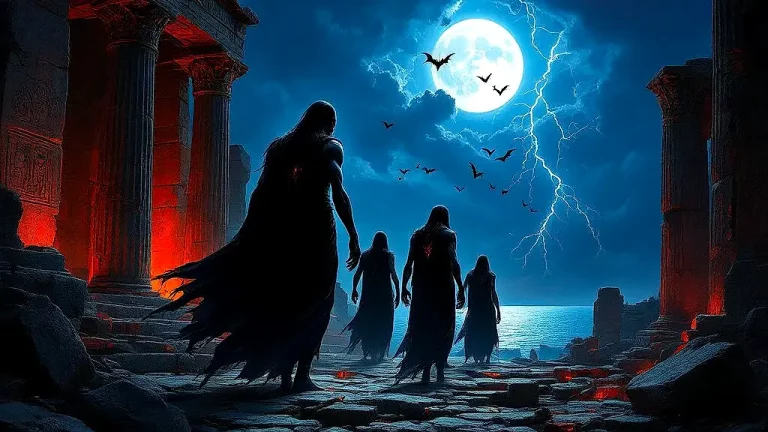Blue Lotus In Egyptian Mythology: Ancient Sacred Flower Lore
Think about walking near the Nile River in old Egypt, where the blue lotus flower grows a lot, its bright petals opening at morning and closing at night. This plain flower had deep importance in the lives of old Egyptians, meaning creation and rebirth and the divine.
Key Points:
- Blue lotus in ancient Egypt symbolized creation, rebirth, and was linked to the sun god Ra.
- Used in religious practices for offerings to gods and purification rituals.
- Seen in Egyptian art and buildings, like tomb paintings, temple carvings, and jewelry.
- Linked to gods like Nefertem, Ra, Osiris, and Isis in Egyptian mythology.
- Had spiritual uses for meditation, dream incubation, and temple ceremonies.
- Used in healing practices for reducing pain, calming effects, and overall wellness benefits.
- Modern studies show active components like apomorphine and nuciferine with potential mind and health benefits.
In this blog post, we will explore the deep stories about the blue lotus, looking at its symbolic meanings in myths, its part in religious acts, and its showing in images and buildings.
We will also find out stories of gods like Nefertem and Ra, who are closely linked with this holy flower, and look at its soul and health uses in old times and now. Whether you are into myths or just curious, this trip into the world of the blue lotus will show why this flower was, and is still, a sign of beauty, mystery, and going beyond.
Blue Lotus Egyptian Mythology: Overview and Key Facts
| Key Point | Description |
|---|---|
| Official Name | Nymphaea caerulea, its plant name |
| Common Names | Also called Blue Lotus, Egyptian Lotus, Blue Water Lily |
| What It Stands For | Creation, Rebirth, Sun, Purity, these ideas |
| Gods Linked | Ra, Nefertem, Osiris, and Isis are tied to it |
| Meaning in Myths | Ra comes out of it, Nefertem’s symbol, ties to Osiris and Isis |
| Ways Used in Religion | Used in temples, funerals, and day-to-day worship |
| How Shown in Art | Seen in tomb paintings, temple carvings, and jewelry |
| Medical Uses | Treating different sicknesses, making people healthier |
| Mind and Spirit Uses | For different states of mind, spiritual learning |
| Today’s Uses | Modern spiritual acts, health methods, and in today’s art and culture |
Why the Blue Lotus Mattered in Ancient Egypt
To fully get the importance of the blue lotus in old Egyptian culture, we need to look at its meaning, how it was used in religion, and how it was shown in art.
What the Blue Lotus Meant in Egyptian Stories
In old Egyptian stories, the blue lotus was more than just a pretty flower, it stood for powerful ideas like start, new life, and god-like things. Much like the morning sun signaling a new day, the blue lotus was seen as a sign of the sun’s daily path.
The flower’s way of opening in the morning and closing at night was similar to the path of the sun god Ra, who was thought to come from a blue lotus at the start of everything. That link with Ra made the blue lotus a sign of living, light, and new beginning, it was a big part of the Egyptian view of the world.
The blue lotus also had an essential part in many stories and was linked with many gods. For instance, Nefertem, the god of fixing and beauty, shown with a blue lotus, it showed his link to making and new things. The flower is also part of the stories of Osiris and Isis, where it meant coming back to life and living forever. Some main gods and stories where the blue lotus stands out:
- Ra: Coming from the blue lotus showing start and the sun’s path.
- Nefertem: Shown with the blue lotus, meaning fixing and beauty.
- Osiris and Isis: Sign of coming back to life and living forever in their stories.
The blue lotus symbolized new beginnings, light, and the essence of life in ancient Egyptian beliefs, often linked with prominent gods like Ra, Nefertem, Osiris, and Isis.
How the Blue Lotus Was Used in Religious Practices
In old Egypt, the blue lotus was a big part of religious events, like how incense and candles are used in today’s religious events to make a holy space. The flower was often in temple offerings to gods, showing clean and divine beginning. Priests would give blue lotuses during daily worship, thinking that the flower’s smell and look would make the gods happy and bring good things.
Also, the blue lotus as part of clean rituals, where its part was thought to clean and make holy both people and holy places.
The importance of the blue lotus even spread to burial ways. It was often put in tombs, the journey to the afterlife and new life, it showed. The flower’s link with the sun god Ra and coming back to life made it a strong sign of life forever. Here are some specific things where the blue lotus had a big part:
- Temple Offerings: Given to gods during daily worship and special festivals.
- Purification Rituals: Used to clean and make holy people and places.
- Funerary Practices: Put in tombs to show the journey to the afterlife and new life.
- Festivals: Shown in parties honoring gods like Ra and Nefertem.
How the Blue Lotus Showed Up in Egyptian Art and Buildings
The blue lotus was a big design in old Egyptian art and buildings, like how roses are in Western art to mean love and beauty. Surprising, the blue lotus appeared in many art shapes, from tomb pictures to temple carvings and even in jewelry.
In tomb pictures, the blue lotus was often shown in pictures of the afterlife, showing new life and the forever trip of the spirit. These pictures often had the dead person holding or surrounded by blue lotuses, their link to the divine and the hope for a good afterlife it showed.
In temple carvings, the blue lotus was used to decorate columns and walls, making a holy and calm feel. Picture walking through an old temple seeing detailed carvings of blue lotuses, each petal carefully detailed to show the flower’s beauty and meaning. The blue lotus also found a place in jewelry, made into charms, necklaces, and rings, worn by both living and dead as a sign of safety and god’s liking. Here is a table comparing different art shapes of the blue lotus:
| Artistic Representation | Description |
|---|---|
| Tomb Paintings | Pictures of the afterlife, dead person holding or surrounded by blue lotuses |
| Temple Carvings | Decorating columns and walls, making a holy space |
| Jewelry | Made into charms, necklaces, and rings, showing safety and god’s liking |
Stories About the Blue Lotus
To really understand the blue lotus’s importance, let’s look into some of the interesting tales and stories where this special flower has a big part.
The Story of Nefertem and the Blue Lotus
Nefertem, the god of health and beauty in old Egyptian stories, is closely connected to the blue lotus. You might find it surprising that Nefertem is often shown coming out of a blue lotus, showing his beginning and god-like being.
Just like how some saints are linked to specific symbols in Christian symbols, Nefertem’s link to the blue lotus shows his role as a giver of beauty and health. The story tells us that Nefertem was born from the first waters and was held by the blue lotus, the flower itself being a symbol of creation and new life.
This picture points out the flower’s importance in his stories, showing purity, health, and the life-giving force of nature.
The Tale of the Sun God Ra and the Blue Lotus
Picture the wonder of old Egyptians as they told the story of Ra, the strong sun god, coming out of the blue lotus. The story says Ra was born from the flower parts of the blue lotus that floated on the first waters of Nun, showing the beginning of everything.
Like the sun rises from the edge bringing light and life to the world, Ra’s coming out of the blue lotus means the birth of the universe and the round nature of life.
These strong pictures show the blue lotus’s role as a sign of creation and new life, pointing out its importance in Egyptian stories as a sign of the forever loop of life and the divine order of the cosmos.
The Blue Lotus in the Story of Osiris and Isis
Picture old Egyptians as they told the story of Osiris and Isis, where the blue lotus was important for showing coming back to life and forever life. In this story, Osiris, the god of the afterlife, was brought back to life by his loyal wife, Isis, after being killed by his sibling Set.
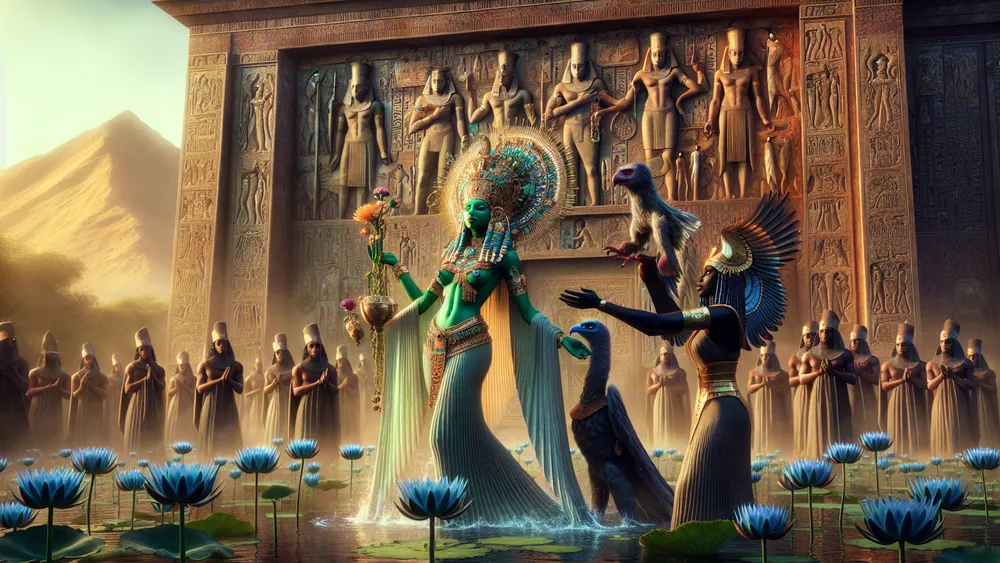
In pictures of Osiris’s coming back to life, the blue lotus shows the new life and the promise of forever life. Like a bird coming back from its ashes, the blue lotus coming out of the water means the winning of life over death. These strong pictures show the flower’s importance in Egyptian stories, pointing out its role as a sign of rebirth and the forever loop of life, death, and coming back to life.
The blue lotus symbolized rebirth and eternal life in ancient Egyptian stories, notably in the tale of Osiris and Isis.
Blue Lotus: Heavenly and Healing Uses
Besides its story-related importance, the blue lotus also was important in the soul-related and healing practices of old Egypt. Let’s see how this special flower was used to heal the body and lift the soul.
Spiritual Uses of the Blue Lotus
Picture old Egyptians using the blue lotus not just as a sign, but as a thing for soul knowledge. The mind-soul importance of the blue lotus in old Egyptian life was deep. This special flower was thought to have the power to change states of mind, letting people link with gods and get soul knowledge.
Just as incense is used today in religious acts to make a calm place, the blue lotus was used to boost soul happenings. Its mind-changing effects were believed to open the mind and soul, helping people get a better grasp of everything and where they fit in it.

You can picture old Egyptians doing many mind-soul ways that included the blue lotus. These ways were made to use the flower’s magical effects and had special acts and events aimed at bigger thoughts. Some main mind-soul ways with the blue lotus were:
- Meditative Rituals: Using the blue lotus to go into a calm state and link with gods.
- Dream Incubation: Taking the blue lotus to have clear dreams and get messages from gods.
- Temple Ceremonies: Using the blue lotus in special acts to boost soul happenings.
- Healing Sessions: Using the blue lotus in healing special acts to help mind and soul health.
Healing and Health Benefits of the Blue Lotus
Picture old Egyptians using the blue lotus not just for its soul importance, but also for its health benefits. In old Egyptian healing ways, the blue lotus was much appreciated for its power to fix a variety of problems and help general wellness.
Like how we use herbs now, the blue lotus was used to reduce pain, bring down swelling, and make people calm. Its calming effects were really helpful for fixing worry and sleeplessness, putting people in a calm state. Plus, the blue lotus was believed to have love-enhancing effects, improving both physical and mental health.
This use in many ways for health shows the blue lotus’s importance in old Egyptian healing ways, showing its role in keeping both the body and mind healthy.
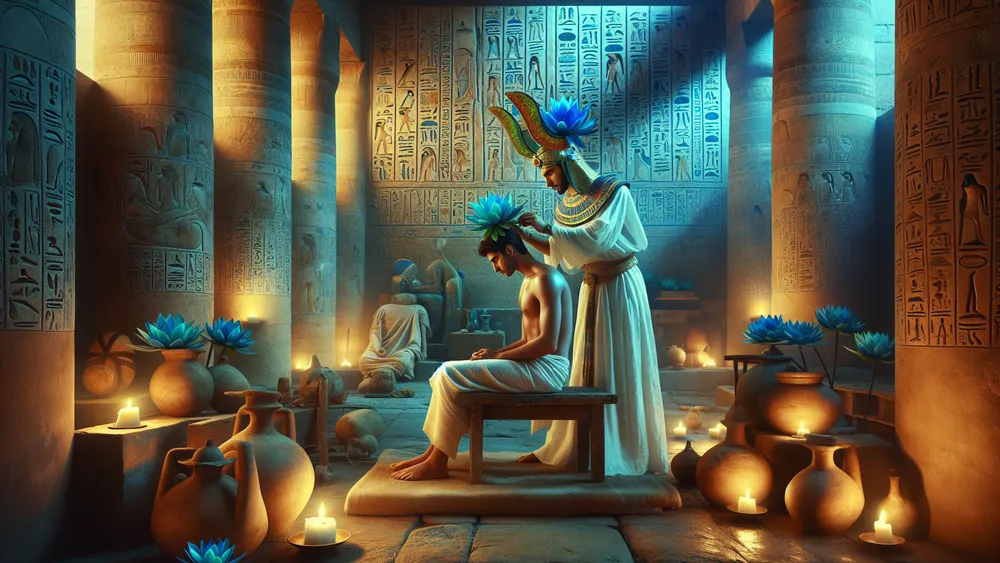
What Modern Science Says About Blue Lotus
Picture researchers today exploring the secrets of the blue lotus, much like old Egyptians did. Current studies have found main active parts in the blue lotus, one called apomorphine and another named nuciferine. Apomorphine is known for its mind-changing effects, working on the dopamine receptors in the brain, which can make you feel good and relaxed, similar to how coffee makes you awake.
Nuciferine, on the other hand, has possible health benefits, like anti-swelling and stopping oxidation, much like how aspirin is used to reduce swelling. These findings suggest that the blue lotus not only had big soul and healing uses in old times but also could be useful for modern healing ways.
Seeing the Blue Lotus Today
Although the blue lotus was very important in old times, its influence is still strong in today’s ways and society. Let’s look at how this special flower is seen and used in today.
The Blue Lotus in Today’s Spiritual Practices
Picture adding the blue lotus into your today’s soul practices, much like how important oils or tools for meditation are used now. Today’s soul practices and whole-body healing respect the blue lotus for its calm and mind-clearing qualities.

You might find it in smell therapy, where its extract is used to help you relax and think clearly, like how lavender extract is used to calm your thoughts. In meditation habits, the blue lotus is often used to make deep meditation and make you more aware of the soul, like scent sticks or certain ways of breathing.
Its importance in whole-body healing can also be seen, as healers use it to even out energy and help general wellness, showing its old part in helping body and soul health.
The Blue Lotus in Today’s Art and Culture
You can see the effect of the blue lotus showing in today’s art, books, and popular culture, like well-known symbols such as the peace sign or the yin-yang are used today. In today’s art, the blue lotus often shows up in paintings and sculptures, symbolizing cleanliness, new life, and soul knowledge.

Picture a modern artist using the blue lotus to show change and new start, like how the old Egyptians did. In books, the blue lotus is frequently mentioned in writings that look at soul trips and mysteries, as a way to show waking up and inner calm.
Today’s culture also takes in the blue lotus, its picture shows up in everything from clothing designs to tattoos, where it shows a link to old saying and looking to get better. This long-lasting sign continues to grab and lead, connecting old times and now through its lasting beauty and deep messages.
FAQs
1. What is the historical significance of the blue lotus in ancient Egypt?
The historical significance of the blue lotus in ancient Egypt lies in its symbolic representation of creation, rebirth, and its association with the sun god Ra.
2. How was the blue lotus used in ancient Egyptian religious rituals?
The blue lotus was used in ancient Egyptian religious rituals primarily as an offering to the gods and in ceremonies symbolizing creation and rebirth.
3. What are the psycho-active properties of the blue lotus?
The psycho-active properties of the blue lotus include inducing mild euphoria, relaxation, and altered states of consciousness.
4. How is the blue lotus used in modern times?
How the blue lotus is used in modern times includes its application in spiritual practices, holistic healing, and as a psycho-active substance.

